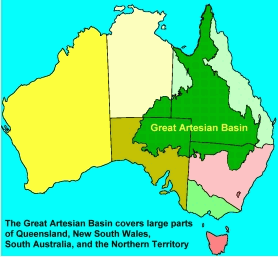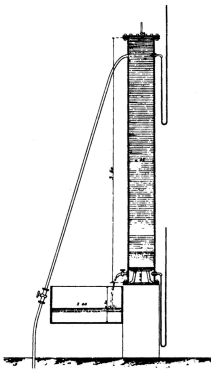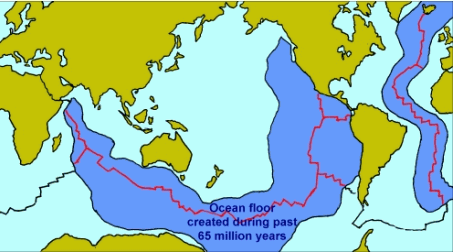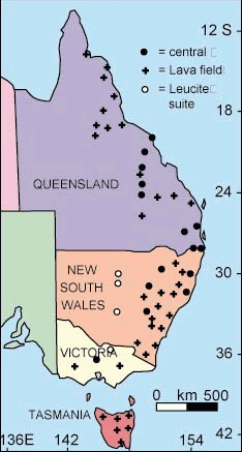John Walter Gregory, FRS. DSc. (1864-1932)
Gregory began his career as a geological assistant in the British Museum in London in 1887 and began his academic studies in the evening at the Mechanics Institute. He then went on to the University of London, where he gained B.Sc. (First class honours) (1891) and D.Sc. (1893).
Working with British Museum, he obtained a very wide range of geological experience in a few years. In 1891 he visited the Rocky Mountains and the Great Basin in America. In 1896 he went as a naturalist on an expedition to Kenya. The expedition disintegrated and Gregory organised his own expedition and with 40 Africans covered 1650 miles in 5 months. He explored the Rift Valley, the nearby volcanoes ,lava fields, and geothermal springs, and the glaciers of Mount Kenya. At the same time he was recording the flora and fauna of the area and the native peoples whom he met.
His book, "The Great Rift Valley" was published in 1896. The book reveals a fascinatingly erudite and highly observant explorer. He then went on an expedition to make the first crossing of Spitzbergen and also travelled to the West Indies. Meanwhile he completed a 3 volume catalogue of the fossil bryozoa held by the Museum. He became a Fellow of the Royal Society.
In 1899 Gregory was appointed Professor of Geology at the University of Melbourne. His qualifications for the appointment were so outstanding that the London committee did not interview any of the other candidates.
The geology of Australia became his new field of exploration, and he travelled widely. In 1901-02 he took a group of students on a field trip to Lake Eyre and studied the artesian bores. He wrote a book about this trip, "The Dead Heart of Australia", which was published in 1906.
Chapter 17 of the book is entitled "The Flowing Wells of Central Australia". It is a most scholarly analysis of the origins of the water. In my studies of the Great Artesian Basin I have looked at many papers on the subject, but in my opinion the Gregory analysis has an outstanding breadth and intellectual quality that has not been equalled, in 100 years!
The following are some direct quotations from the book. It reads as if it was written yesterday.
Extracts from book by J.W Gregory, "The Dead Heart of Australia" 1906
"Subterranean water may be derived from one of two sources. Cool water, which occurs at comparatively slight depths, is no doubt, generally, rain-water ....As this water comes originally from the sky it is called 'meteoric' water..
The second source of subterranean water is the interior of the earth. The rocks of the deeper layers of the earth's crust contain water. The quartz in granite owes its milky whiteness to abundant minute cavities, filled with water. The vast steam cloud, which hangs over volcanoes,...has no doubt been brought.. from the interior of the earth.
Plutonic waters are especially important in mining countries, because most of the chief ore-deposits are due to them. And as the deep, water-bearing basin of Central Australia is surrounded on all sides by rocks containing rich mineral veins - from the Queensland gold-fields on the east, the Cobar copper-field and Broken Hill in the south, and the Cloncurry god-field in the west -, there is likely to be a considerable amount of plutonic water under Central Australia.
Where these ascending waters are cut off from the surface by an overlying sheet of clay, they accumulate in any porous beds they can enter, and remain in them subject to high pressure. Any plutonic water rising from the old rocks of Central Australia would collect in the permeable beds of sandstone beneath the clays. Thence it would rush to the surface, if a bore-hole were made through the water-tight cap above, just as oil and natural gas escape from the wells of the Caspian and Pennysylvania....
The tendency has always been to assign the origin of the flowing wells to distant localities. The ancient Egyptians supposed that the water which flowed from the artesian wells of Thebes came from the hills of Darfur, 700 miles to the south.
The source of the water of the famous well at Grenelle, near Paris, has been attributed to the Jura Mountains. Is, therefore, only in accordance with precedent, that the source of the deep-well waters of Lake Eyre should be sought in the mountains of New Guinea, the Andes, and the Himalaya...
The possible origin of Australian artesian water from the Himalayas or New Guinea was suggested, amongst others, by the Hon. J. T. Murray Prior, in a debate in the Queensland Legislative Council. "The great question must be", he said, "where does the artesian water come from? The nearest high mountains we have to Australia are in New Guinea; but still the water may actually come from as far as the Himalayas under the sea."
The explanation of the flowing wells of Central Australia as due to water-pressure in the distant Queensland hills is met by many difficulties. One of the chief is, that it under-rates the resistance to the flow of water through rocks due to friction. The analogy between the geological structure of eastern Australia and a U-tube fails, because Australia is not built up of tubes. The water has to percolate, not through open tubes, but through the pores of rocks; and as these rocks are under the pressure of sometimes as much as four or five thousand feet of overlying material the pores will be minute.
The average increase of temperature below the surface of the ground is generally taken as 1degree F for every fifty-three feet in depth...But many of the flowing wells in Australia show the rate of one degree F for every twenty-two feet. This high temperature indicates that the water has probably come from a much greater depth than that of the water-bearing layer. It is, therefore, more likely to be plutonic than meteoric water...
The association of compressed gas with the artesian waters has been denied or doubted, but it is admitted that many of the well-waters smell of sulphuretted hydrogen. Many of the Queensland waters are charged with carbonic acid.
I long hesitated before finally rejecting the ordinary artesian theory of the Central Australian wells, The question is not merely one of settling a theoretical explanation. It has an important practical bearing. Many of these wells now run to waste.
This waste is defended on the ground that the water is being renewed at a rate which so vastly exceeds the outflow from the wells, that they will last for ever without any diminished flow...
Legislation to stop this waste has twice been proposed. A Bill was carried through the Queensland Assembly in 1891; but the Legislative Council rejected it. In New South Wales a similar Bill was proposed in 1894, which would have authorised the Water-conservation Department to order the partial closing of the wells; but it also failed to pass.
Nature has stored up a vast - but probably a limited - supply in a safe, underground reservoir.. But to allow these deep-well waters - in obedience to a mistaken analogy as to their origin - to run heedlessly to waste, is a policy of which a later generation of Australians may have bitter cause for complaint."
Of course, Gregory was quite right. Here we are 100 years later, and we have not yet learned the simple truths that Gregory explained so clearly.
It is understandable that other people at that time, including geologists, had difficulty in comprehending such clear statements by Gregory. After all, he was probably the only person in Australia with such a scientific background in the subject.
In 1904 he left the University of Melbourne for an appointment at the University of Glasgow. His later books reveal a scholarly range that may not have been achieved had he stayed in Australia. The debate on the origin of the waters lapsed.
In 1911 there was talk of a five thousand pound prize for the best essay on the origin of the waters, but it seems that any essay along the lines of thought of Gregory was not likely to win the prize.













